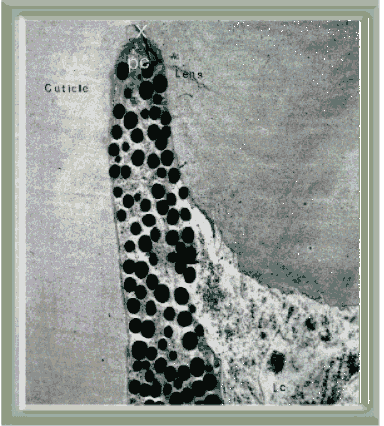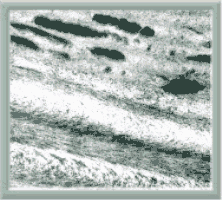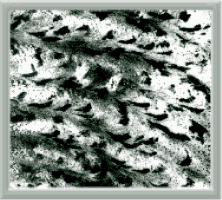Fine Structure of the Eyes of Harvest-spiders - Shielding Pigment
Back to Opiliones Notes
You can see electron micrographs of pigment
cells in the eyes of Mitopus morio and Oligolophus agrestis
in the picture quiz for February.
Light enters the eye through the lens and is focussed on to the photo-sensitive
retina.
Undue scattering of light in the retina is prevented by pigment granules
which are packed into the photoreceptive cells themselves. These granules
are rather discoid, sac-like structures - as shown in the quiz
picture for February and they are prominent organelles in the retinula
cells of the retina.
In addition to this retinula cell pigmentation, at the side of the eye
there are masses of pigment to stop light entering other than via the lens.
You can see these clearly in this image from the eye of Mitopus
morio,
where the pigment cells (pc) show nicely between the lens and the peri-optic
cuticle, as well as lateral to the lentigen
cells (lc) which underlie the lens.
Other features also protect the eye, such as the flat
square crystals in hypodermal cells that we have seen in O. agrestis.


Interestingly, pigment cells appear to be absent from the eyes of another
species, Nemastoma bimaculatum.
This small animal has very dark, sclerotised cuticle. This means that
its exoskeleton is very hard and tough - suiting its mode of life pushing
through leaf litter and the top layer of the soil. Its also means that
the intense black colour of its cuticle prevents the entry of light and
so pigment cells are not needed.
Thus, in these two images of the cuticle of N. bimaculatum,
we can see deposits of electron-dense material (presumably the pigment)
actually within the cuticle itself, as shown in these two images. Note
how the material seems to be oriented with the microfibrils of the cuticle.
.
This information is based on electron microscope observations described
in:
Curtis D.J. (1968) Fine structural studies on the eyes of Phalangida.
Ph.D. thesis, University of Liverpool.
For further details, see:
Curtis, D.J. (1970) Comparative aspects of the fine structure of the
eyes of Phalangida (Arachnida) and certain correlations with habitat. J.
Zool., Lond. 160: 231-265.
and
Curtis, D.J. (1969) The fine structure of photoreceptors in Mitopus
morio (Phalangida). J. Cell Sci., 4: 327-351.




